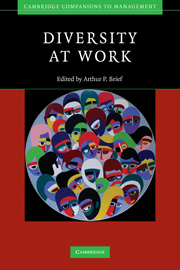Book contents
- Frontmatter
- Contents
- List of figures
- List of tables
- List of contributors
- Foreword
- Preface
- 1 Introduction: Where the sweet spot is: Studying diversity in organizations
- Part I Conceptual foundations
- Part II Emerging theoretical approaches
- Part III Moving ahead: Agendas for practice and research
- 8 Diversity initiative effectiveness: What organizations can (and cannot) expect from diversity recruitment, diversity training, and formal mentoring programs
- 9 was not that long ago: A story of gateways and pathways
- Index
- References
8 - Diversity initiative effectiveness: What organizations can (and cannot) expect from diversity recruitment, diversity training, and formal mentoring programs
Published online by Cambridge University Press: 19 May 2010
- Frontmatter
- Contents
- List of figures
- List of tables
- List of contributors
- Foreword
- Preface
- 1 Introduction: Where the sweet spot is: Studying diversity in organizations
- Part I Conceptual foundations
- Part II Emerging theoretical approaches
- Part III Moving ahead: Agendas for practice and research
- 8 Diversity initiative effectiveness: What organizations can (and cannot) expect from diversity recruitment, diversity training, and formal mentoring programs
- 9 was not that long ago: A story of gateways and pathways
- Index
- References
Summary
The organizational literature began emphasizing the “business case” for diversity in the late 1980s (Cox and Blake, 1991; Johnston and Packer, 1987; Robinson and Dechant, 1997). The business case predicted a range of benefits resulting from greater workforce diversity within organizations (Jayne and Dipboye, 2004; Konrad, 2003). Specifically, an organization making maximum use of the talent available in the labor pool would select a diverse group of employees. These diverse employees would be more effective in dealing with a diverse customer base, and the diverse employees would bring a greater range of perspectives to bear on organizational decision making. In sum, “a more diverse workforce, [managers] say, will increase organizational effectiveness. It will lift morale, bring greater access to new segments of the marketplace, and enhance productivity” (Thomas and Ely, 1996: 79). The business case for diversity, and its optimistic expectations of the benefits achieved through employee diversity, has been enthusiastically embraced by managers. In a Catalyst-sponsored study of 15 Fortune 500 companies, every corporate executive interviewed by the researchers cited the business case as the primary rationale for their organizations' diversity efforts (Giscombe and Mattis, 2002). And there is evidence of a trickle-down effect to the employee level: a diversity program accompanied by a “competitive advantage” justification is likely to generate the most positive employee attitudes (Kidder et al., 2004).
Given the widespread acceptance of the business case, it is ironic that the academic literature has documented so many negative outcomes associated with workforce diversity.
- Type
- Chapter
- Information
- Diversity at Work , pp. 265 - 317Publisher: Cambridge University PressPrint publication year: 2008
References
- 62
- Cited by



